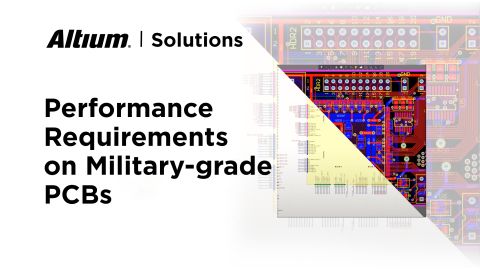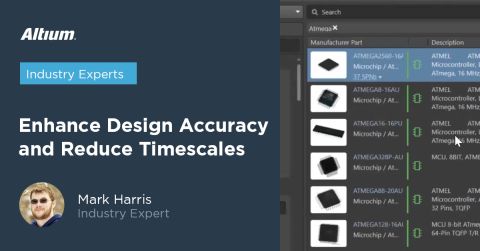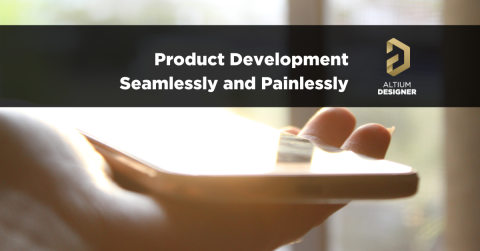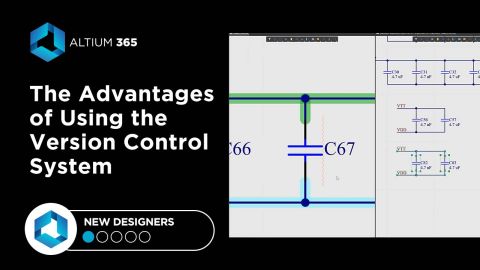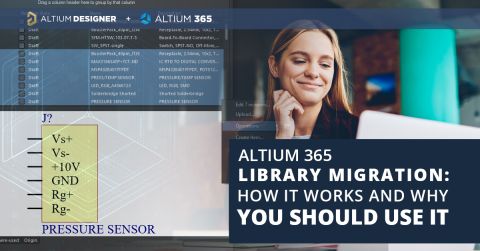Leveraging Altium Designer's Capabilities: Transforming PCB Design Data Management

In an era where the demand for cutting-edge, reliable products is at an all-time high, Altium Designer emerges as a pioneer. Altium Designer redefines PCB design with its remarkable abilities in managing, accessing, and synchronizing PCB project data. This article explores the transformative impact of its advanced features, such as PLM integration, versioning and revisioning through Altium 365, efficient components and libraries management, and invaluable insights into the supply chain data, on the entire PCB design process.
PLM Integration: Elevating the Design Process through Digital Transformation
Altium Designer's integration with Product Lifecycle Management (PLM) systems establishes it as a frontrunner in the digital transformation of PCB design. Moving away from manual design processes that are prone to inefficiencies and costly revisions, Altium Designer's integration with PLM systems establishes a new benchmark for managing, accessing, and utilizing design data across a product's lifespan.

Cross-domain Consistency: Bridging the Gap Between ECAD and PLM
The collaboration between Electronic Computer-Aided Design (ECAD) and Product Lifecycle Management (PLM) systems forms the foundation of Altium Designer's integration with PLM. This active two-way synchronization of metadata guarantees that information related to components, projects, and manufacturing remains harmonized across both platforms. The barriers that previously caused inconsistencies and communication breakdowns between the design and manufacturing teams have been removed. This level of unification is essential not only for maintaining the integrity of the design and manufacturing workflow but also for ensuring that the final product meets the original designs requirements, thereby avoiding costly adjustments.
Digital Connectivity: A Unified Design and Manufacturing Ecosystem
Altium Designer provides an integrated digital environment where ECAD or PLM system components are easily created and managed. This interconnectivity streamlines what used to be intricate design and manufacturing processes to foster a workflow that's both more efficient and less prone to errors. Through this fluid information flow, designers and manufacturers can collaborate in a way that reduces project expenses and accelerates the launch of new products to the market.
Full PLM Data Structure Creation: Democratizing PLM Access
One of the most significant barriers to leveraging PLM systems is the complexity and specialized knowledge required to utilize them effectively. Altium Designer's integration with PLM systems dismantles this barrier, allowing designers to create a complete PLM data structure—including source, manufacturing, and documentation files—without requiring deep expertise in PLM. This democratization of access to PLM benefits is a critical step towards ensuring that all designers, regardless of their background in PLM, can leverage the advantages it offers.
BOM Structure Digital Connection: Ensuring Integrated Design and Manufacturing Data Management
Linking the Bill of Materials (BOM) from Altium Designer directly to PLM systems completely changes how you manage design and manufacturing information. This link automatically updates the PLM system with any modifications to the BOM, safeguarding the reliability and precision of the manufacturing details. By doing so, it dissolves the traditional barriers that once divided design and manufacturing efforts, promoting a unified and productive approach to product development lifecycle.
Versioning and Revisioning Empowered by Altium 365
Altium Designer's integration with Altium 365 revolutionizes the way versioning and revisioning are managed in PCB design projects by improving project data integrity and traceability. These are key elements in ensuring the reliability and success of electronic designs.

Complete Project History & Visual Comparison: A New Standard for Transparency
Altium 365 introduces an unmatched level of clarity and governance over modifications within projects. It keeps a detailed record of all changes, including who implemented them, when, and why. This extensive history is invaluable for teams tackling intricate designs, as it aids in understanding how the project has evolved—critical for diagnosing issues and refining the design.
The visual comparison tool further augments this by allowing designers to visually inspect differences between versions of schematics, layouts, BOMs, and Gerber files. This capability is instrumental in quickly identifying unintended alterations or errors, significantly reducing the time and effort required for revision checks. It fosters a culture of accountability and precision, ensuring that every change is deliberate and beneficial to the project's progression.
Granular Access Control & Git Version Control: Enhancing Security and Collaboration
Altium 365's secure workspace introduces advanced access control mechanisms, enabling administrators to precisely dictate who can view or modify various elements of the project. This granular access control is pivotal in protecting sensitive design information, mitigating the risk of unauthorized access or intellectual property theft.
Moreover, the integration of Git version control, a standard in software development, into the hardware development process, marks a significant innovation. Git's robust version control capabilities are tailored within Altium 365 to suit the unique needs of PCB design, facilitating better collaboration among team members. It ensures that changes are tracked and merged efficiently, reducing conflicts and simplifying the review process. This integration not only secures intellectual property but also enhances teamwork by streamlining collaboration across different project aspects.
Full Traceability & Design Reuse: Streamlining Compliance and Maximizing Efficiency
Altium 365 offers full tracking of each alteration made to the design, a critical aspect for industries where meeting compliance and undergoing audits is essential (E.g. medical devices). This tracking capability makes it straightforward for teams to show they're following approved design norms and meeting regulatory standards, thereby easing the compliance journey.
In addition to aiding compliance, Altium 365 promotes design reuse, a practice that can significantly accelerate project timelines and reduce costs. By maintaining a detailed history and making previous designs easily accessible, the platform encourages designers to leverage existing components and circuits in new projects. This not only optimizes productivity but also helps maintain consistency and reliability across projects.
Centralized Components and Libraries: Transforming PCB Design Workflow
Altium Designer's way of managing components and libraries marks a significant step forward in updating the PCB design workflow. By bringing these essential resources together in one place, Altium Designer greatly improves the design process's speed and precision. This is particularly vital in the rapid environment of today's design work, where having current and correct component details is critical for a project's success. Let's explore how Altium Designer's centralized components and libraries are changing the game.

Manufacturer Part Search Panel & Components Synchronization: Ensuring Component Integrity
At the core of Altium Designer are the Manufacturer Part Search (MPS) Panel and the Component Synchronization feature, which are both crucial for maintaining component integrity. These functionalities provide immediate access to a broad database of manufacturer parts, enabling designers to:
-
Monitor Supply Chain Risks: With supply chain volatility being a major concern, having real-time insights into component availability and risks is crucial. This allows designers to make well-informed choices, selecting parts that are most accessible and least risky;
-
Ensure Accurate Part Details: A direct connection to manufacturers' databases guarantees that component information is both accurate and current, reducing the chance of errors from manual inputs or outdated data, thus increasing design dependability;
-
Synchronize Components: This ensures any manufacturer updates or changes are automatically updated in the designer’s library, saving time and guaranteeing that designs are based on the latest component specs.
Part Requests & Lifecycle Management: Streamlining Component Selection
Altium Designer also makes selecting components easier with part requests and thorough lifecycle management.
-
Facilitating Part Requests: Designers can request new parts to be added to the centralized library, ensuring that the library evolves with the project's needs. This process is streamlined within Altium Designer, allowing for quick addition and approval of new components, ensuring that the design team has access to all necessary parts without delays;
-
Implementing Lifecycle Management: Each component within Altium Designer's library is assigned a lifecycle status, indicating its availability and obsolescence risk. This feature allows designers to make strategic decisions about component selection, prioritizing parts that are readily available and have a lower risk of becoming obsolete. By doing so, Altium Designer mitigates potential supply chain disruptions and ensures the long-term viability of the design.
Leveraging Real-Time Supply Chain Insights in PCB Design
The collaboration between Altium Designer and top-tier supply chain data vendors represents a major advancement in tackling the evolving challenges of today’s electronics supply chain. This integration equips PCB designers with immediate updates on component costs, availability, and potential risks, reshaping decision-making throughout the design lifecycle. Let’s examine how these insights enhance the design process, making it more streamlined, knowledgeable, and flexible.

Transforming Component Selection with Immediate Availability Data
Altium Designer introduces a transformative feature for PCB designers; instant access to component availability. This tackles a critical hurdle in choosing components that meet design needs, are readily available, and are cost-effective.
-
Informed Decision Making: Designers receive real-time updates on component availability, crucial for making informed choices and preventing design adjustments or delays due to parts shortage or long lead times.
-
Cost Efficiency: The ability to instantly compare prices allows designers to choose components within budget without sacrificing quality or performance, crucial for keeping the final product competitive and profitable.
-
Enhanced Production Timelines: Choosing readily available components minimizes the risk of delays, ensuring project deadlines are met and the product launch schedule remains intact.
Navigating Supply Chain Complexity with Confidence
Incorporating real-time supply chain data into Altium Designer breaks new ground beyond conventional PCB design tools, offering designers the confidence and adaptability to handle the global electronics supply chain's complexities.
-
Risk Management: Enhanced capabilities to evaluate and mitigate risks due to component scarcity, obsolescence, or geopolitical issues allow designers to adapt their component choices proactively, lessening the project's exposure to supply chain fluctuations;
-
Smoother Design-to-Production Transition: Armed with precise, real-time data, designers can secure a seamless move from design to manufacturing. This not only shortens the market time but also bolsters collaboration between design teams, production, and manufacturing partners.
Conclusion: Altium Designer as a Comprehensive Ecosystem
Altium Designer revolutionizes PCB design and manufacturing by seamlessly integrating traditional approaches with digital innovation and PLM integration to ensure unparalleled efficiency and accuracy from conception to production.
Enhanced by Altium 365, features like detailed project history and strict access control facilitate collaborative, secure, and streamlined design processes. Centralized component management enables informed decisions based on real-time data, enhancing process efficiency and product reliability. Integration with leading supply chain data providers offers vital insights into component availability and risks, empowering designers to navigate supply chain complexities effectively.
Together, Altium Designer and Altium 365 provide a dynamic framework for confidently tackling modern PCB design challenges with innovation.
